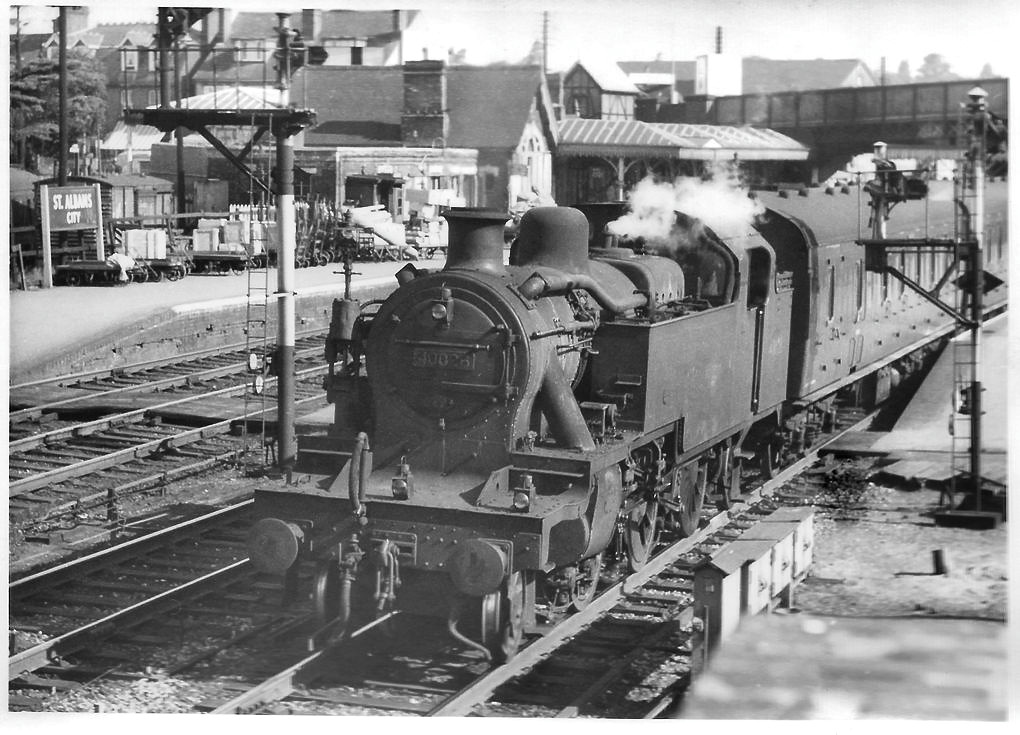#London Midland and Scottish Railway
Text

Poster for the London Midland and Scottish Railway Derby Staff Ball (1931).
#vintage poster#1930s#ball#party#dancing#staff ball#dancers#masquerade#derby staff ball#london midland and scottish railway#lms railway#british
58 notes
·
View notes
Text
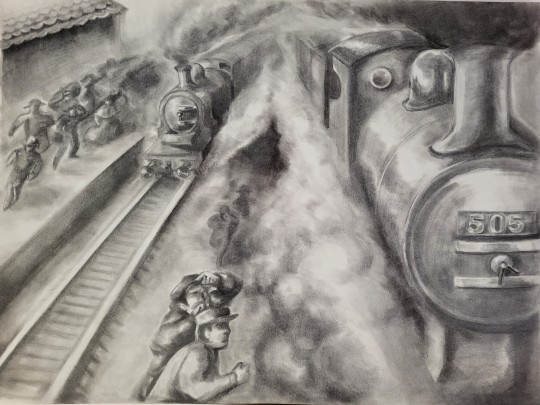
"Runaway on the LMS", 2022, graphite
Close ups:


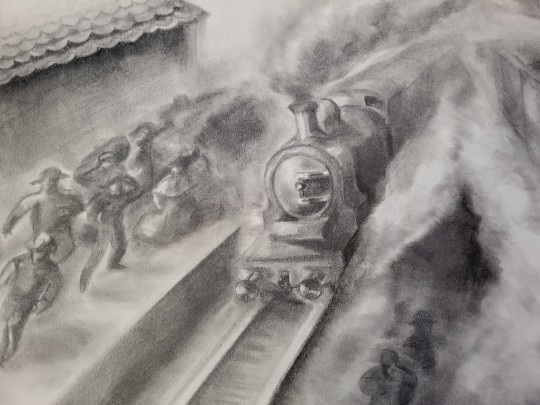
Please do not repost without permission!
#randomly remembered that this existed while i was cleaning my room#and its WAY too good not to post#i worked on it for about 2 weeks maybe 3#and it was for college assignment#the engines have no particular basis but feel free to speculate!!!#humans will always be fucking impossible to shade w graphite istg#real life railway#kips art#art#steam locomotive#london midland and scottish railway#artists on tumblr#traditional art#college artist
227 notes
·
View notes
Photo

Henry, aka the LMS Black 5...who needs an update. Also I need to do more LMS engines.
14 notes
·
View notes
Note
oohh can I hear a bit of the Duchess of Hamilton Guider?
fast gorl
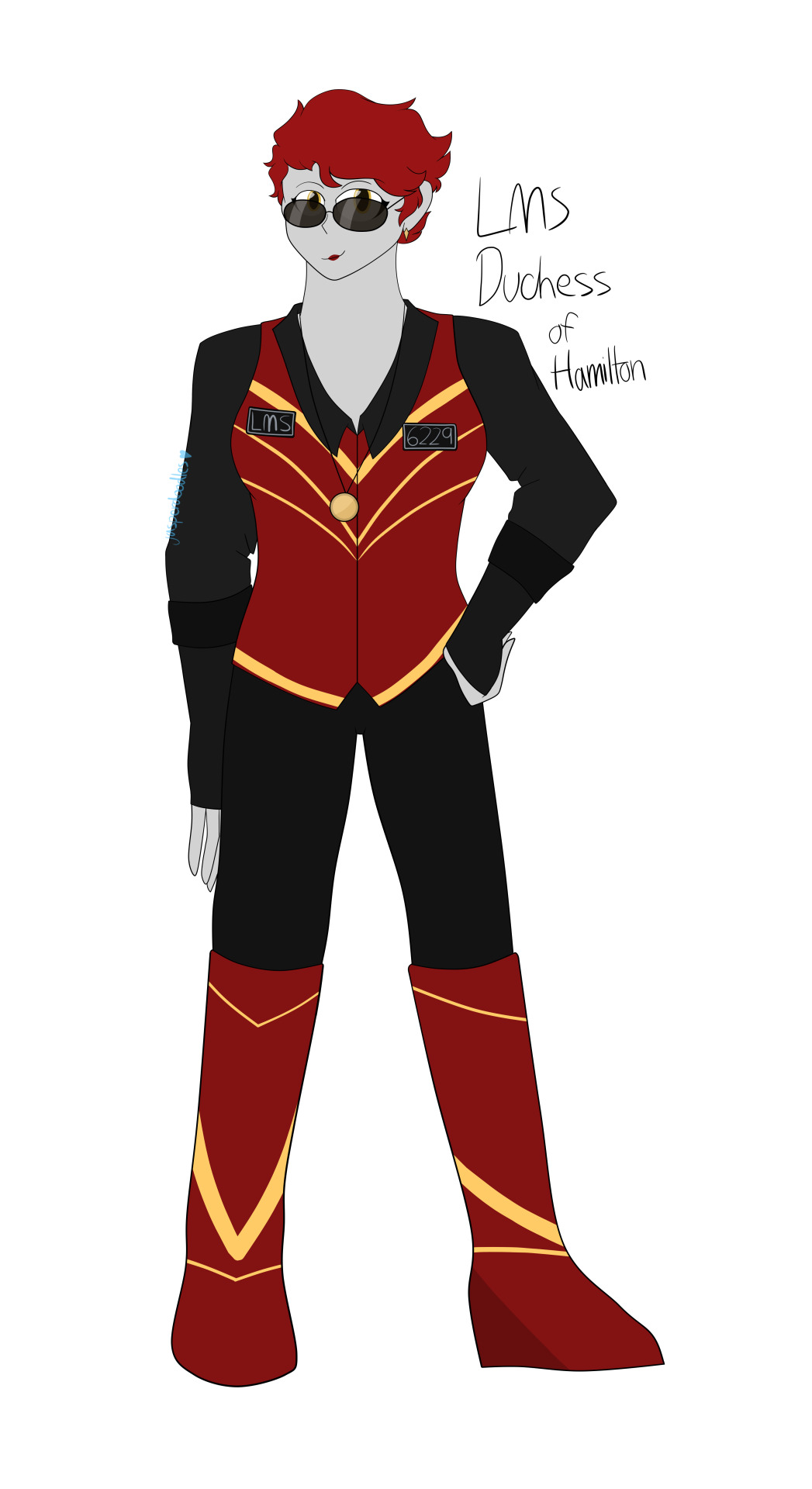
LMS #6229, the "Duchess of Hamilton"
Basic information: 6'3 inches tall, 84 years old, she/her, streamlined.
Personality: When it comes to NRM guests, she is quick to provide as much information as she can and is regarded as being very helpful while on duty. She's also very humble (compared to her old personality) and enjoys being a static display. She's very reliable as well, being quite encouraging to those around her. Especially her siblings and the other Guiders at the NRM. Sadly, she has a bit of a short fuse and can get defensive really easily, as well as being a little bossy when things don't go her way.
Going off of that, she still has a mindset of "You need to be fast! You need to be the best!" This lead to her being a little bossy and having a short fuse. This was a common mindset for British Guiders, which became stronger and more relevant during World War 2.
She's very close to her sister, Duchess of Sutherland, her sister and her brother, City of Birmingham. She's also close with the other Guiders at the National Railway Museum, such as Stephenson's Rocket, Green Arrow, and Flying Scotsman. The only person she inherently dislikes is Mallard. (which is understandable, he's an asshole.)
Despite the fact she was designed by Stanier, she gets along very well with a lot of Gresley, Peppercorn, and Thompson-designed Guiders. If she has free time, she can usually be seen spending time with Bittern, who she considers her best friend. If she isn't spending time with someone, she's normally spending time alone usually watching TV/Youtube or doing some interior design, usually at a Guider's or the museum's request.
Overall? Very lovely Guider to hang out with.
#rails around the world#ratw#ask#ask response#thanks for the ask!#digital art#digital illustration#jas' art#lms#london midland and scottish railway#lms duchess of hamilton
5 notes
·
View notes
Text


introducing the big four. the main troublemakers. berwyn (GWR) is probably the only one who still has this photo.
ask box is now open as well !
#inbetweenthelines#ibttl4#lner#lms#southern railway#gwr#great western railway#london midland scottish railway#london north eastern railway#ttte#the railway series#railway series#personification#gijinka#thomas the tank engine#thomas and friends#railway#british rail#oc art#digital art
41 notes
·
View notes
Video
British Railways (ex LMS) loco No. 40026 @ St. Albans City Stn. by Frederick McLean
Via Flickr:
An old photograph of tank locomotive No. 40026 at St. Albans City station. No photographer name or date. This was an H. Fowler designed class 3P, 2-6-2T engine, built at the Derby Works and new to the London, Midland & Scottish Railway (LMS) in Feb 1931, carrying No. 15525, renumbered as 26 in May 1934. In 1948 the railways were nationalised, becoming British Railways (BR), engine No. 26 becoming No. 40026 in Oct 1948. The locomotive was withdrawn from service in Dec 1962, then scrapped in Apr of the following year (location unknown). If there are any errors in the above description please let me know. Thanks. 📷 Any photograph I post on Flickr is an original in my possession, nothing is ever copied/downloaded from another location. 📷 -------------------------------------------------
#LMS#BR#London#Midland and Scottish Railway#London Midland & Scottish#old photograph#old transport#vintage transport#vintage photograph#2-6-2T#tank engine#class 3P#H Fowler#40026#Derby Works#St Albans City#locomotive#old locomotive#steam loco#steam locomotive#vintage steam loco#old train#steam train#vintage train#old steam engine#vintage steam engine#British Railways#railway station#flickr
2 notes
·
View notes
Text

London Midland & Scottish Railway • LMS
Le Meilleur Service de Chemin de Fer Anglais
~ Raymond Virac (French, 1892-1946), circa 1925
10 notes
·
View notes
Text

0 notes
Video
Mytholmes by Treflyn Lloyd-Roberts
Via Flickr:
"Bahamas" passes over the viaduct at the approach to Mytholmes Tunnel. This was during a 30742 Charters event on the Keighley and Worth Valley Railway. Locomotive: LMS Stanier Jubilee Class 4-6-0 45596 "Bahamas". Location: Mytholmes, near Haworth on the Keighley & Worth Valley Railway, West Yorkshire.
#Bahamas#pass#viaduct#approach#Mytholmes#Tunnel#30742#Charters#event#photo#charter#Keighley#Worth#Valley#Railway#steam#Locomotive#London#Midland#Scottish#LMS#Stanier#Jubilee#Class#4-6-0#45596#Location#Haworth#K&WVR#West
0 notes
Text

Rail Archive Stephenson. London Midland & Scottish Railway. Chester, United Kingdom
#unknown photographer#black and white#photography#vintage#united kingdom#art#history#black and white photography#vintage photography
767 notes
·
View notes
Text
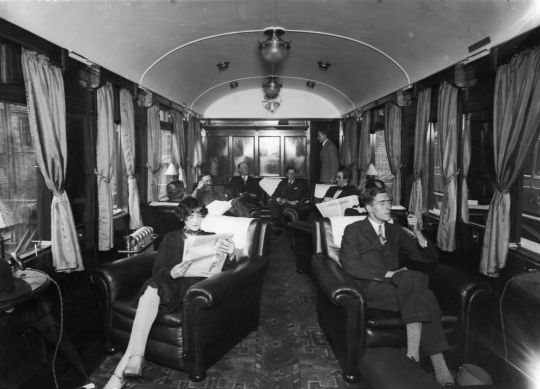
The London Midland and Scottish Railway's Royal Scot First Class Lounge , 1928.
98 notes
·
View notes
Text
Two Ends of the Shed
May 1925

The Adventure Begins (2015)
Word Count: 4,114
James realizes that by listening to outdated engines, he'll end up like them: broken and soon withdrawn.
~
.
.
.
The yard at Barrow-in-Furness was as busy as ever. Engines came or left with their goods trains. LYR 920 was one of them.
The congested yard surprised him and the rest of the locomotives under the newly formed London, Midland, and Scottish Railway. It was only the middle of January, and the Amalgamation had gone into effect at the beginning of that year, 1923. Despite that, he still hadn't been repainted and given his new number. His original brass plaques with the deep green background were still on the sides of his cab, and so were the words "Lancashire & Yorkshire" in bold, bright yellow with cyan shadows painted on his tender.
He was waiting for his goods train to be filled. When he arrived, it hadn’t been filled halfway with whatever goods he would be delivering, so he had to stick around. All he could do was stay put and look around, leading to eventual pouts of impatience, while his crew waited inside his cab.
And that's when she came in.
The small six-driver spotted the larger tender engine with four leading wheels and four driving wheels from a distance. She was painted Deep Indian red with Indian red and black lining, and her eyes were bronze.
LYR 920 furrowed his eyebrows as anger boiled within him. The engine looked uncannily similar to one from the Furness Railway, who was loaned to the Lancashire & Yorkshire Railway in 1914. Though he had never spoken to the engine, especially after the near collision, he heard enough about the engine. Said engine turned out to be hostile, differing from her initial reclusive personality.
Shortly after, however, he learned that her class was demoted to regular passenger service after she left. The rumors were that the class was currently working mixed-traffic work.
Serves her right! he thought then. Give her a struggle! Engines like her aren’t meant for hard work like mine!
So the minute the ex-Furness Railway engine stopped beside him, he tensed but stood his ground. His bulbous nose scrunched up. Steam seeped out of his nostrils and through his lips as his jaw clenched, prepared to bite if necessary.
The larger tender engine peered at him with a smile. "Hello!” She took notice of his frown. Her eyebrows shifted in concern. “Is this yer train?” The ex-Furness Railway engine gestured to the train she'd backed up to, thinking that was why he was upset.
“No. I've already got mine,” he replied nonchalantly, mimicking the Furness engine’s gesture. A way to insult her subtly. “How's life as a mixed-traffic engine?”
“It's quite nice actually,” she replied, though thrown off by the question and how the engine spoke as if he knew her. “It's dirty work but it's no’ bothersome… somewhit. Whit's yer name?”
“Don't worry about it."
"But thon's rude!" she insisted.
The goods engine scoffed. Ridiculous. “Oh, you would know, alright.”
Like a deer caught in headlights, the other engine froze. Her steam got hotter to the point that LYR 920 felt suffocated just standing next to her. “Excuse me?” she asked in a threatening. tone.
“Fess up! I know you’re Alice!” LYR 920 claimed, dismissing his crew, who smacked his backhead. Their protests, telling him to quit it, were fruitless. “Don’t act stupid and not recognize me!”
Fury flashed across her face, leaving as soon as it came. “Din’ ye dare speak o’ her like thon,” she hissed, her voice full of prey’s venom, before exclaiming. “We dinnae look yon same!”
Oh dear.
“She’s dead!” she continued, the fire sparked within her eyes, roaring at the smaller engine. But before she began ranting, her fireman climbed out of the cab and onto her running board, rushing towards her smokebox. Her words caught the attention of nearby workers, who initially ignored the confrontation between the two engines.
He whispered soothing words, calming her down, and didn’t dare touch her smokebox. Just stepping on her running board was all his feet could tolerate, the heat from her boiler spreading to the rest of her metal parts.
Once her steam wasn’t suffocatingly hot, she asked, “Whit is yer name?”
Weird was the only word, and an understatement, the smaller engine could use to describe her behavior. Both he and his crew were bewildered, even more so with the sheepish, apologetic smile her fireman gave them before the latter rushed back to his engine's cab.
Yet, LYR 920 answered.
Might as well.
Not like I have anything better to do, he thought, glaring at the yardmen still filling up his goods train. Oh for heaven's-
And just like that, he stopped himself. He was getting ahead of himself like an impatient dog. "I don't have a name,” he finally replied.
Again, the larger engine's eyebrows shifted, confused. Her behavior was going to make LYR 920 dizzy if she didn't stop. It was difficult to follow and process. "Ye…” she began, registering his response, “...dinnae hae a name?"
"Nope," he replied. "Not as privileged as the passenger engines."
"Eh?” she squawked, catching the attention of those nearby. “Guids engines can hae names, too!" she argued. The English engine wondered if this behavior was normal within this class. "Whit’s yer number then?"
LYR 920 eyed the other engine suspiciously. "But that's improper from what I hear."
“I said, ‘Whit's yet number?’”
"Nine-Twenty."
"Awrite, Nine-Twenty. Mine is Fourty-Five."
"Nawsense!" she exclaimed with a quick huff. "It's no’ fair thon I huv a name but ye dinnae, sae we shall go by numbers.”
And just like that, a guard blew his whistle before LYR 920 could say anything. The smaller engine felt his driver tapping against his backhead. He bid FR 45 farewell and left for his destination.
.
.
.
Thundering through the Ballahoo Tunnels, the black mixed-traffic engine hauled a goods train to Knapford Harbor. He passed by dull green junctions, the brick stations on the Main Line, and the branch lines. Every time he’d pass by them, he noticed that all but two branch lines were closed. Time had done its thing to some of them, covering rusted iron tracks in mangled branches. Twigs intertwined and dragged everything around it with a tight but fragile grip.
Time had not been so kind.
The more time that passed, the more James wanted to go back home. Home to his friends. Home to his older sister. Home to a place that he knew the most and could traverse easily without having to learn any new malicious trick being played by fellow workers.
It’d been a week since the incident. James refused to sleep on either side of the sheds, claiming the center berth. He was surrounded by the worst. It was either engines talking behind his back or engines who saw themselves above him.
“Slow down, chap!” exclaimed Fred. “Don’t want to burst your safety valve now, do you?”
James perked up. “No, Mr. Quill!” he quickly replied, unaware of how much his frames swayed. Pulling on his brakes, he eased to a slower and safer speed. He heard the raven man hum with approval, despite the thunderous noise of his pistons. A smug grin crept on his face, full of pride.
But as he continued his journey, his rampant thoughts about the other engines raced about. One was violent and a liar, one was an enabler, one was prideful and rude, and another was petty and envious.
He just wanted to go home.
At least his crew came along with him. He was surprised they did.
For once, he was thankful for his old railway's decision.
…
The brick building with the green canopy sunroof that was Tidmouth Station came into view as James continued up the west coast, leaving the green pastures of the countryside behind. He was due to pull the passenger service on the Ffarquhar Branch Line.
As the black mogul pulled into the yard and was uncoupled from his train, he heard a loud steel groan nearby, followed by an engine stopping and someone walking on the ballast. It was coming from the sidings closest to the Big Station. Curious, and with a hum, he wandered over, only to find Edward, sitting idly, and his crew, on their knees and examining the cerulean engine’s chassis. This would've alarmed James and his crew if they hadn't noticed the lack of steam billowing from the smaller engine's chassis.
“Hey, Charlie! Everything alright there?” hollered Mr. Quill as he leaned over the side cutout of James’ cab.
“Old boy’s broken down!” Charlie grumbled without looking up. His engine glanced at the other but stayed quiet, which the latter rolled his eyes to.
Unaware of the present tension between the two, Fred asked, “Want us to take him to the works?”
Bronze and heterochromatic eyes shrunk. Edward quickly looked away, breaking the one-sided eye contact. In protest, James jerked, only to get a flick against his cab.
Damn it!
“Please do!” thanked Charlie, patting Sidney on the back before getting up and climbing into Edward’s cab.
Within minutes, accompanied by grumbles and pouts, James was coupled up in front of Edward. He blew his whistle, startling the workmen in the yard, Edward, and said engine’s crew, before departing for Crovan’s Gate.
The trip was silent.
…
Much to his dismay, James had to fill in for Edward. Grumbles and pouts sputtered from his lips as he huffed about the yards, shunting trains left and right.
“How could an engine break down from work like this?” he grumbled as he aggressively bumped a truck into others. His whining was loud enough to catch the ear of his Express service co-worker.
“It was about time,” Gordon replied. His response startled James, who’d been unaware of his presence.
Once James composed himself, he asked, “About time?”
“Edward is old. The four-leader, four-driver may have been the newest, the best, the pinnacle standard… but those days are over. They have been for a very long time.”
“That doesn't mean he can't do basic shunting,” James argued, leaving out what he wanted to say. This engine was talking to him as if he didn't know. For goodness’ sake, he was friends with an entire class of 4-4-0s, or the 7 of the 8 that remained, that is, and his former co-workers of those 4-4-0s from the Lancashire and Yorkshire Railway were still going.
Gordon scoffed. “Tender engines aren't meant to shunt, little James.” He ignored James’ little “Why you-!” “The yards are much too small for a tender engine to shunt about.” He rolled closer towards James, and the venom of his voice thickened as he continued. “His days are numbered. That’s just how it goes. He may have paved the way for engines like me,” he boasted, “but his importance will cease to exist. There is a reason why the Fat Director continues to bring on better engines. Engines that are meant to be and will be better.”
Though James wanted to be furious, he couldn't. He wouldn't straight up admit it to the egotistical express engine beside him but Gordon was right.
For one, as much as James didn't want to admit it, afraid of putting down his older friends, 4-4-0s were losing importance. James heard this happen time and time again in the other three railways, before and after his rebuilds. The Atlantics quickly came in, followed by the Pacifics, claiming the prestigious express passenger services of their predecessors. Six-drivers, like he once was, were taking the goods services as quickly as they were given to the 4-4-0s, simply because that was their job. 0-6-0s were made for that job, as opposed to the 4-4-0s, who were designed for express passenger services and any other more important trains.
His friends and former colleagues were lucky that their railway refused to follow those examples, opting for the small-engine policy of the old Midland Railway.
But how long would that last?
The simple fact of the matter was that newer whytes were better and more efficient. 4-4-0s were slowly becoming a second option and would eventually become the last.
And while his previous owners dismissed his experimental rebuilds as a waste of time and deemed him a failure, the Fat Director did not. He must've seen value in him. Why else would the young gentleman buy him? The praises he would receive for his “splendid performance” only proved it; the Fat Director's words, not his own.
He was wanted because he was better. He was bought because he was better.
With that in mind, James spent the rest of his day with no complaint and pure pride.
…
Days passed by the time Edward returned from the works. James saw him ease into the yard, the lack of steam still prevalent, and halt. Bronze eyes inspected the area until he perked up once they landed on James.
As quickly as he could, the Edwardian-styled engine puffed over to the Edwardian goods engine. The latter immediately veered somewhere else but the former persisted and followed.
“James, may I speak wit’ ye for a moment?” Edward asked as he caught up to the other. He could feel the anger fuming from his steam. It was suffocating and unwelcome, and Edward couldn't blame him.
“What?” James replied, annoyed. His natural brash tone seeped fury in it, startling Edward.
However, the smaller engine pressed on. “I want tae apologize for no’ tellin’ ye why ye were in the yards in the first place.”
James scoffed and rolled his eyes. “I still don’t get why you thought it was necessary to do that.”
“I didnae want tae hurt ye.”
“Ha! Well, guess what? You. Did,” he snapped.
The smaller engine stayed put. It was easier with his crew holding onto his brakes. “I-I ken! And I’m truly sorry.”
“Say sorry all you want but I’m not taking it!” huffed James, blasting steam directly at Edward.
The little engine yelped and jerked at the sudden heat spewed at him, knocking his crew off their feet. Once his crew lost their grip, Edward was able to back away. Just enough to get away from the heat irritating his metallic-like face.
As Edward’s eyes fluttered and his freckled face scrunched, James rushed off without another word. Besides his pistons pumping, the yardmen could hear James’ crew scold their engine, audibly upset. Their protests were in vain, however, as James left the yard without stopping.
Once his vision cleared up, the small cerulean engine frowned. His brow scrunched and his nose twitched as frustration bubbled within his boiler.
…
James thundered down the Main Line with his goods train, still fuming from what took place at Tidmouth. Fred kept an eye on his steam pressure, which went crazy for a bit, as George, a dirty blond Englishman, tried getting his engine’s attention. His attempts were fruitless as the mogul engine crossed the Vicarstown Bridge and dismissed the tapping against his backhead and cab. From there, the pair let their engine be.
The yardmen at Barrow-in-Furness were startled by James’ loud three-chime whistle, having gotten used to not hearing it for over a month, as it announced the engine’s arrival. The shrill had gotten the attention of all the engines there. All of them bore LMS in yellow on their tenders and were painted in either black or red. One engine in particular, who had been humming about as she waited for the yardmen to empty her train, perked up at the familiar sound. Slowly, she shifted her frame, dipping her cab end slightly, to get a look over the other awaiting trains.
Meanwhile, James was led to the same area she was in for the workmen to disembark the goods. He pulled up two tracks left of the engine, facing north like she was, and came to a sudden halt.
The sound caught the other engine’s attention, and she immediately peered over. Once she saw him, she gasped, “Fifty-Six?”
The black medium-sized tender engine froze before flipping his smokebox door open to face his right side. His eyes landed on the bronze-eyed engine, and excitement bubbled within him. She was a Class 21 from the Furness Railway, about the same size as he was, and painted LMS Crimson Lake red. Her old number, FR 45, was replaced with her LMS number years ago.
“Thirty-Eight!” exclaimed James.
“It’s sae guid tae see ye!” exclaimed LMS 10138. “How’s Sodor, huh? How is it?”
“Oh! It’s- uh- interesting!” he replied, lying through his clenched teeth with a fake grin. “No other railway quite like it!”
“I told ye! We both did!” she recalled cheekily before chuckling.
“You certainly did!” he strained again, joining her laughter.
Once their laughter died down, LMS 10138's expression changed suddenly. She looked at James with suspicion, making the modified Class 28 nervous. While she was sweet to him and their friends, she was truly a menace to not be messed with. It was then that James realized how foolish he was to think she wouldn’t notice his mood. She was the oldest survivor of her sisters, keeping a hawk’s eye on them as much as possible.
“It’s no’ goin’ sae well, ain’t it?” she asked, leaning towards him.
Despite feeling nervous, James admitted to it. “No, it's not.”
“Whit’s goin’ oan?” she asked softly, her tone now different from just before. “Dinnae tell me it’s those Pacific engines.”
“It’s not them,” replied James. “You and Fifty-five were wrong about them. If anything, they’re nicer than the other two.”
“Nicer?” repeated LMS 10138 before laughing in disbelief. “Ye’re jokin’, richt? Those Pacifics were yon worst of the North Westerns."
"Well, they probably manipulated you into thinking that, Thirty-Eight."
Her eyebrows furrowed, scrunching her face. "Or maybe thon's whit those Pacifics huv done tae ye," she retorted.
"I'm not stupid!"
"I didnae say ye were!" huffed the crimson-red engine. "I'm jist worrit for ye… er-" She peered at his tender. "North Western Six?"
"It's James," corrected the North Western.
"Pardon? Ye huv a name?" she inquired as excitement practically sparkled from her eyes. "Och, ye huv a name!" cheered LMS 10138.
Pride filled the black tender engine's boiler. "Oh, yes I do!" he boasted. "Now can I know yours?"
"Nah, thon would’nae be far tae the twins and Fifty-Five," she replied.
James pouted and thought. As the workmen continued emptying his trucks, an idea struck him. "What if we gave them names?"
"Whit?"
"We can give them names!" exclaimed James. "Who said that only people could give us names?"
LMS 10138 hummed. "Ye huv a point,” she replied after considering it. “A very guid ane! Let’s go tell ‘em.”
“Right now?”
“Aye!” she replied, nudging her frame to her left. “The twins and yer sister ur here, too!” With swift movement, LMS 10138 popped her smokebox door open, jerking her body to the side. The motion, unnecessary but natural, grabbed her crew’s attention. “Can we please see ‘em?” she asked her crew, who pulled themselves back up from the sudden jolt.
While most crew typically didn’t bother acknowledging their engines, the eldest of the remaining Larger Seagulls was lucky that hers were willing to. “I dinnae see why no’,” replied her driver as he peered over to James’ crew. “Ye up for it?”
“Might as well,” replied Fred. “We’ve still got a good while before we leave. Come on, chap!”
James cheerfully whistled, joined by LMS 10138's bright FWHEE-EEP!, sounding remarkably like her class’ nickname-sake. Both engines, once uncoupled, left the area in search of the other three. Much to their luck, the twins and James’ sister were waiting to depart with their goods trains. The twins were to head back up north while the other Class 28 was to head down south. The oldest of the twins caught sight of the Larger Seagull and “Class 29” heading their way. “‘Ey, look!” he exclaimed, catching his brother and the Class 28’s attention. “It’s Fifty-Six!”
“Fifty-Six?” repeated the Class 28 as she perked up and flipped her smokebox door open. “It is him!”
“Fifty-Five! Fourty-Six! Fourty-Seven!” piped up James as he came into audible range. “Were you about to leave?”
“We should in a bit,” replied the youngest twin. “We were supposit tae leave a while ago but somethin’s goin’ oan up aheid.”
“Somethin’ aboot a stallit train,” murmured the oldest twin, LMS 17646. He and the other twin, LMS 17647, were Class 652s of the Caledonian Railway, having been given LMS Black. They followed the same color scheme as Fifty-Five and James did. “How’s it goin’, big man?”
James playfully scoffed at the nickname. Ever since he’d come out of Horwich Works from his rebuilds, the twins drilled in the nickname as, in their own words, “Ye’re the biggest o’ us now, mate!” They weren’t wrong as he was a few centimeters taller than LMS 10138. “It’s… something,” James eventually replied.
His friends became concerned. “What happened?” asked Fifty-Five. “They’re not picking on you, are they?”
“No, it’s not that! It’s…” James struggled to form his sentences but he just couldn’t. “It’s complicated. I don't want to talk about it.”
His friends grimaced, growing concerned for James.
“But I come with news and an idea!” he exclaimed, nudging the Crimson red steam engine.
LMS 10138 announced, “He's got a name! And he thinks we should come up with names for ye three!”
“A name?” exclaimed the three six-drivers, eyes shining with excitement.
“James! Given to me by the director himself!” he puffed proudly.
“By the director?” squawked LMS 10138.
“Ye really are the big man!” exclaimed LMS 17647.
“I'm so happy for you, James!” squealed LMS 12555. “Such a lovely name!”
James beamed with pride. “Thank you!” he replied. “Now, what about names for you three?”
The five engines pondered and proposed names for a while. The disturbance that was preventing the Class 28 and the Class 652s from leaving still wasn’t cleared.
“Whit aboot ‘Katherine’?” suggested the red Larger Seagull.
“Do I look like a ‘Katherine’?” asked LMS 12555.
“Mmm, naw,” replied LMS 10138. “No’ ane bit.”
“‘Lily’?” proposed James.
“She's small but no’ thon light,” said the oldest twin.
“Hey!” exclaimed the black Class 28. “At least I didn't get something like ‘William’ and ‘Billiam’,” she mocked, sticking her tongue out while being careful not to curl it up.
“Aye, I wonder who'd come up wit’ such names,” the youngest twin wondered loudly, eyeing James.
“Now that's just mean,” huffed James.
“Those were pretty bad,” LMS 10138 noted.
“Fine! What about ‘Jasmine’?”
The others stayed quiet before looking at LMS 12555. Her brown eyes sparkled with adoration. “Jasmine…” she repeated. “I love it! Jasmine!”
“Then ‘Jasmine’ it is!” exclaimed the oldest twin.
“Now what aboot us?” inquired the other.
“Well, I'm out,” replied James. “What about you two?” he asked the newly named engine and the other whose name was still unknown.
“I was thinkin’ ‘Donald’ and ‘Callum’,” suggested LMS 10138.
“What about ‘Barclay’ and ‘Douglas’?” added Jasmine.
“Absolutely no’,” hummed LMS 17646, “but I like ‘Donald’.”
“And I like ‘Douglas’,” piped LMS 17467. “‘Donald and Douglas’...”
The other engines thought, mutters amongst them.
“We like it!” exclaimed the twins.
“So do we!” agreed the other three.
“Come on, Thirty-Eight!” exclaimed Jasmine. “What's yours?”
With a well-meant eye-roll, LMS 10138 replied, “Goldilocks. Ma name is Goldilocks.”
“Oh, like the little golden-haired girl from that story about the three bears?”
“Aye! Even ma nickname is an ‘homage’ tae the story.”
“Hold on,” interjected James. “How do you get named?”
“Well, it's nawthin’ special, really,” the Larger Seagull replied. “When I first steamit, a workman stood in front o’ me, pointit at me and said, ‘This lassie looks like a Goldilocks.’ The same thin’ happenit tae ma siblin’s-!”
“Hey, you three!” hollered a yardman, pointing his finger at the three 0-6-0 engines. “You better get going! The line’s all cleared now!”
“Yes, sir!” piped the three engines.
“Bye, James! See you soon!” exclaimed Jasmine, letting out a fierce whistle and going on her merry way. “Take care!”
“Bye, Jasmine!” replied James. “Bye, Donald and Douglas!”
“Huv a safe trip, James!” exclaimed Donald. Both twins blew their whistles, letting out a soprano harmonic shrill before setting off.
Once the trio departed, Goldilocks piped up. “Well, I best get goin’! I got a passenger train tae pull soon.”
“Of course!” piped James before giving a smug grin. “I got to pull a passenger train, too.”
The LMS-red engine gasped. “Passenger service? Look at ye go! Ye’re goin’ tae huv tae tell us more aboot thon next time!” she exclaimed with a chuckle. “Awrite, I must go noo. Bye, James!”
“See you around, Goldilocks!” exclaimed James as Goldilocks whistled and left. Once she was gone, he grimaced.
It was time to go back.
~
Lot of stuff happened with this one!
I took one look at Donald, Douglas, and James being under the same railway before James was sold off and went, "they are brothers."
and because why not, have some trivia!
Goldilocks is a lesbian. Jasmine is demiromantic she/they demi-girl. Donald and Douglas? haven't figured them out yet ("they sure do exist!")
Within this canon, all of the names of the Larger Seagulls are derived from fairytales + folklore from England and Scotland. Following Alice Edward ("Alice's Adventures in Wonderland") and Goldilocks ("Goldilocks and the Three Bears") are Tangle ("The Golden Key"), Mhara ("The Sea Maiden"), Fiorimonde ("The Necklace of Princess Fiorimonde"), Daylight ("Little Daylight"), Speur ("The Daughter of the Skies"), and Emmelina ("The Doll that Came Straight from Fairyland"). Yes, Speur and Emmelina are the youngest two built in 1900, aka Edward's baby twin sisters.
Goldilocks and Jasmine, as indirectly mentioned, were loaned to the NWR during the 1920 Locomotive Crisis. An LYR Class 7 (Atlantic) was also loaned to the NWR during that time period.
Goldilocks' face is a reference to the Orange Chinese Engine from BWBA, which is just a modified version of Edward's model with eyelashes and different textures. They look VERY identical from a distance, but Goldilocks has less of what Edward has. Less freckles, less eye wrinkles, less eyelashes, and her nose isn't as curved up as Edward's. I just thought it would be funny.
James and Jasmine (LMS 12555 and 12556 respectively) are the only LYR Class 28s with a Hughes Twin Plug superheater and a Belpaire firebox.
#engines of sudrian rails (shipverse) by muxse#engines of sudrian rails by muxse#my writing#ttte james#eosr goldilocks#eosr jasmine#ttte donald#ttte douglas#ttte edward#ttte gordon#ttte fic
18 notes
·
View notes
Text
Happy Mallard Day!
Most people in my country will be celebrating tomorrow, July 4th. I’m a bit unusual for an American in that I’m always more excited for July 3rd, because a remarkable feat of engineering history happened that day in 1938 (in multiple senses of the word). Today I’m going to tell the story of a locomotive named for a duck.
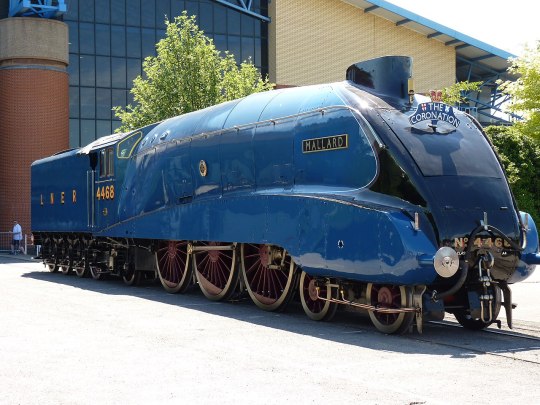
(Image: 4468 Mallard, a streamlined 4-6-2 Pacific locomotive, sitting pretty in York, England, United Kingdom. She is painted bright blue with red wheel spokes.)
The story begins well before July 3rd, 1938, of course - mechanical engineer Sir Nigel Gresley was well established in his position as the CME of the London and North Eastern Railway by that date. In 1923, his most famous creation, a 4-6-2 Pacific A1 numbered 4472, took to the rails for the first time. Originally numbered 1472, within a year of running between London to Edinburgh she received her more familiar 4472 after the LNER finally settled on a company-wide numbering scheme - and the name she’d be best known under, Flying Scotsman. She became the company’s flagship locomotive and solidified Gresley’s ability to design Pacifics in the mind of the public.
Her most important contribution to what I’m about to get into the meat of here, though, occurred on November 30th, 1934. On that date, pulling a light testing train behind her, Flying Scotsman hit 100 mph, becoming the first locomotive to hit that speed whilst being officially measured. Other locomotives may have reached 100 mph before, most notably GWR 3700 City of Truro and NYC 999, but this was the first time the speed was officially recorded, and so Scotsman got her name into the record books.
Dating back to the 19th century, railroads in Great Britain competed against each other in what was known as the Race to the North, in which they actively attempted to outdo each other and get passengers from the south, usually London, up to various destinations in Scotland. Nobody ever actually said they were racing, of course, but in retrospect it was pretty obvious what was going on as the railroads introduced faster and faster services. By the 1930s, the railroads had been consolidated into four companies - the Big Four (the Great Western, the Southern, the London, Midland and Scottish, and the heroes of this story, the London and North Eastern). The LMS controlled the West Coast Main Line, and the LNER controlled the East Coast Main Line. (This is important.) In 1927, the LNER started running the named train Flying Scotsman non-stop from London to Edinburgh, utilizing corridor tenders to perform crew changes at speed without stopping. Not to be outdone, the LMS beat them to the punch, running non-stop services between London and Glasgow and London and Edinburgh on their own, and it was officially on. Although speeds were still within a reasonable range at this point, both railroads knew they needed to go faster, and Sir Nigel Gresley looked to Germany.
In Germany, a new streamlined service called the Flying Hamburger had been introduced. This was a diesel train set that ran between Hamburg and Berlin at remarkably high speeds - it had an average speed of 77 mph and could hit around 99-100 mph at its maximum. For regular service, this was impressive, and Gresley wondered if the same could be done using steam power. He knew streamlining was the key, but the LNER knew that the diesels in Germany didn’t have the same passenger capacity as their steam locomotives could pull in carriages, so he needed to get creative. He looked to Bugatti for inspiration; their racecars, in their resplendent blue, were but one thing the car company was working on - they were making streamlined railcars, as well. Gresley took note of their designs, and his new locomotives would eventually pay homage by being colored Bugatti blue.
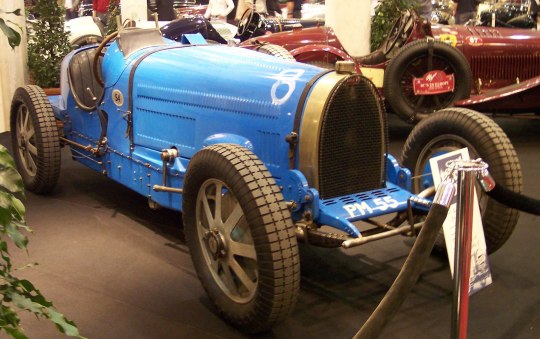
(Image: a Bugatti Type 54 racecar, painted in a vivid blue.)
By the time Flying Scotsman hit 100 mph in 1934 and another Gresley Pacific locomotive, A3 2750 Papyrus, managed to hit a whopping 108 mph without streamlining, the LNER knew that Gresley was capable of the task, and they allowed him to design a streamlined locomotive. Gresley set to work making improvements to his A3 design, and the first four A4s were born.

(Image: an unidentified A4 Pacific locomotive.)
The A4s were fast, hitting 112 mph on the inaugural run of the Silver Jubilee service between London and Newcastle in 1935. Gresley, of course, was not satisfied - he knew he could still improve his design, and at any rate, his competition over at the LMS was going to be trying to catch him. He went back to the drawing board to make the A4s even better.
As this was going on, the LMS was indeed playing catchup, and they introduced their beautiful Coronation class locomotives, designed to pull the Coronation Scot starting in 1937. The first several of them were streamlined in gorgeous, bright casings, and they caused a stir, taking the British speed record back at 114 mph in an attempt by 6220 Coronation that ended with a sudden braking and a whole lot of kitchenware being flung every which way in the dining car. Engineer/driver T.J. Clark and fireman C. Lewis kept her under control, but the passengers were not amused, and speed records were shelved for the time being...until, once again, Germany entered the fray.
Back in 1936, a German locomotive, the DRG Class 05, set a land speed record for steam, hitting 124.5 mph. Gresley was aware of this and had it in the back of his mind as he improved his A4s. He experimented with giving some of them a Kylchap exhaust system, an innovation developed by French locomotive designer André Chapelon after the work of Finnish engineer Kyösti Kylälä. Chapelon’s work went woefully under-acknowledged, but Gresley paid attention and appreciated his work, and it would pay off. Wind tunnel tests proved a bit frustrating at first until a fortuitous accidental thumbprint helped to move the smoke up and over the locomotive instead of in the crew’s faces, and the stage was set.
4468 Mallard rolled off the line at Doncaster Works on March 3rd, 1938, her name derived from Gresley’s love of breeding waterfowl. Indeed, many of her sibling locomotives were also named for birds, like 4464 Bittern, 4467 Wild Swan, 4902 Seagull, and 4903 Peregrine, but the duck was about to steal the show. Mallard spent the next few months getting used to working and being broken in so she wasn’t brand new, and on the day she turned four months old, it was time to make history.
Mallard’s driver that day was a 61-year-old grandfather named Joe Duddington. As a locomotive engineer, he was experienced and knew how to take calculated risks, and so he’d been assigned to pilot her. With him on the footplate was fireman Tommy Bray and his massive tattooed arms, ready to keep Mallard fed as they drove into the history books. They were performing a “brake test” that day, or so the LNER told most people, passengers included, but Joe and Tommy knew what was actually going on. In the cab with them was an LNER official, Inspector Jenkins, and attached to the train behind the tender was a dynamometer car, there to record Mallard’s speed throughout her run. Since this was an alleged “brake test” the dynamometer car didn’t raise any eyebrows right away. Gresley himself unfortunately wasn’t in the best health that day and was unable to be present himself, but there were enough LNER officials on hand to see to it that everything ran smoothly. Mallard was fitted with a stink bomb of sorts of aniseed in case the big end bearing for the middle of her three cylinders overheated, as the A4s had previously had difficulty with this, and she set out heading northwards. The return trip was where everything was going to get serious.
Upon turning around to return south to King’s Cross, passengers were finally informed of what was going to happen and were given the opportunity to disembark and take another train if they were worried, especially given what had happened during the LMS record attempt a year prior. Everyone agreed to stay on board. Joe Duddington turned his hat backwards, a reference to George Formby’s character in the film No Limit, and opened the throttle.
Mallard slid back onto the main line, headed towards Grantham, where the speed-up was to begin. Unfortunately, work on the track limited her to only 15 mph at this stage, and Joe Duddington got her through the Grantham station at only 24 mph instead of the 60-70 mph she should have been at. Nevertheless, she began to build up more and more speed as she climbed up Stoke Bank, and Duddington had her at a solid 85 mph at the summit.
“Once over the top, I gave Mallard her head, and she just jumped to it like a live thing,” Duddington recounted later in an interview. Her speed rapidly increased, and she was soon hitting 110 mph, at which point he told her, “Go on, old girl, we can do better than this!” Mallard responded, and by the time she was flying through a village called Little Bytham, a blur of blue paint and pumping rods and flying ash, she had well exceeded the LMS record and was even with the German DRG Class 05. The needle in the dynamometer car tipped up higher and higher and surpassed the Class 05 by slipping up to 125 mph...then, for about a quarter of a mile, reached even higher, at 126 mph. She’d done it.
Mallard had to slow down soon after because of a junction, but Joe Duddington and Tommy Bray were sure she could have gone faster had they not had to slow for construction - they believed she was capable of 130. The big end bearing did overheat, and Mallard was detached from the train at Peterborough and brought back to Doncaster to be fixed up, but not before one of the most famous photos in railroad history was taken:
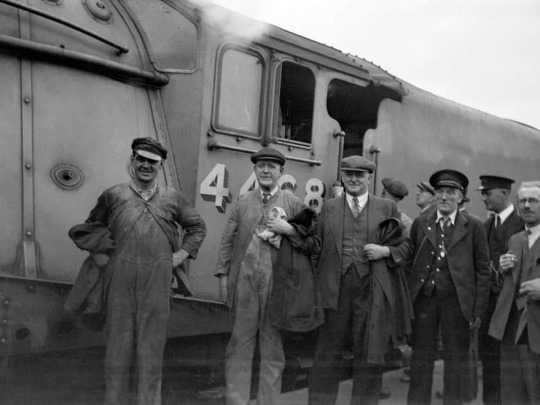
(Image: the crew poses in front of Mallard, a 4-6-2 Pacific locomotive numbered 4468, immediately after setting the speed record. L-R: Tommy Bray [fireman], Joe Duddington [driver/engineer], Inspector Jenkins, Henry Croucher [guard/conductor]. Joe Duddington has turned his hat around to face the correct way again after having it on backwards during the record run. Photo credit: National Railway Museum.)
Joe Duddington actually stayed on a bit past his retirement age to help free up soldiers for the war effort. When he finally retired, on his final day of work, he drove Mallard one last time.
Sir Nigel Gresley himself never accepted the brief stint at 126 mph, instead saying his locomotive set the speed record at 125 mph. But history has accepted the 126 mph as the true top speed, given that Mallard was possibly capable of even more, and today she has plaques on her streamlined cladding to commemorate her feat. A second record attempt was planned to see if she could go even faster, but World War II broke out and the idea was scrapped.
undefined
youtube
Tommy Bray eventually got on the throttle himself, fulfilling his own dreams. Both men are honored in a cemetery in Doncaster with a new memorial headstone for Duddington featuring Mallard on it.
As for Mallard herself, she continued working until April 25th, 1963, at which point she’d clocked nearly a million and a half miles in service. She was pulled for preservation for obvious reasons, and today she lives at the National Railway Museum in York, along with her dynamometer car that recorded her history-setting run. Five of her A4 siblings also survive, and a few of them are operational to this day, including the one named for her designer, Sir Nigel Gresley. Of all of his ‘birds,’ the one that flew fastest was the humble duck.
For more on Mallard and her creator Gresley, here are a few resources:
Mallard: How the Blue Streak Broke the World Speed Record by Don Hale is a great book on the subject that I enjoyed thoroughly. It does have a Kindle edition if you’d prefer an ebook variation, as well, and most major book retailers carry it on their websites.
The National Railway Museum, Mallard’s retirement home, has a 3D experience/ride of sorts that simulates what it was like to be running with her that day, the video of which is online here. Note the music, which mirrors her three cylinders pumping away. The video isn’t able to be embedded, but you can watch it here. There’s also a child-friendly version, too.
Lastly, the appropriately named prog rock band Big Big Train did a song about Mallard called East Coast Racer, which regularly moves me to tears because this locomotive means so much to me and they tell her story so lovingly.
undefined
youtube
I actually recommend checking out the live version, too, because they show the photo of the crew at the end and every single time I start sobbing.
If you want to visit the old girl herself, she’s at the National Railway Museum in York in the UK, and they have a ton of amazing resources and incredible locomotives and rolling stock in their collection. I’d highly recommend checking them out if you can!
Happy Mallard Day, everyone. Fly far, fly fast, make history.
#LNER Mallard#LNER 4468 Mallard#LNER#LNER A4#I like trains#I spent literal hours on this whoops#but she's really important to me
50 notes
·
View notes
Text



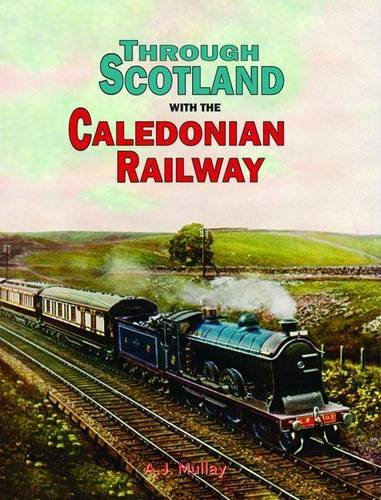
On February 15th 1848 the Caledonian Railway company opened.
The trains of the Caledonian Company were recognisable by their blue livery decorated with the royal arms of Scotland. At the height of its success in the first half of the twentieth century, the Company controlled almost 3,000 miles of track and had extensive holdings, including hotels, steamers and harbours.
Although the company was supported by Scottish shareholders, the majority of its shareholders were actually based in England. The Caledonian Railway Company also opened a railway which crossed the border between Scotland and England, replacing what had been an arduous journey involving a sea trip via Liverpool in order to reach London.
The Caledonian Railway Company came to an end in 1923, when it was amalgamated into the London, Midland and Scottish Railway. (LMS).
16 notes
·
View notes
Text
London North Eastern Railway = LNER
Southern Railway = SR
Great Western Railway = GWR
Sooooo....Shouldn't London Midland and Scottish Railway = LMSR?
38 notes
·
View notes
